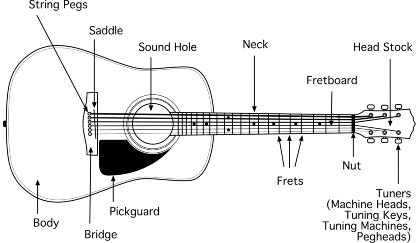Know Your Guitar
Main Guitar Parts
 Headstock: Headstock or peghead is a part of guitar or similar stringed instrument. The main function of a headstock is holding the instrument's strings. Strings go from the bridge past the nut and are usually fixed on machine heads on the headstock. Machine heads are used to tune the guitar by adjusting the tension of strings and, consequentially, the pitch of sound they produce.
Headstock: Headstock or peghead is a part of guitar or similar stringed instrument. The main function of a headstock is holding the instrument's strings. Strings go from the bridge past the nut and are usually fixed on machine heads on the headstock. Machine heads are used to tune the guitar by adjusting the tension of strings and, consequentially, the pitch of sound they produce.
Tuning keys: With the help of these keys the tune of the guitar can be adjusted. If you really want to be a guitar expert will show you how to tune the keys sometime later in the blog.
Nut: This adjust the string vibration. Remember, this can adversely affect tuning stability.
Fret: On the Neck, the "spaces" in between the "lines". Thats about as simply put as it can be. It's kind of tough to explain. On the neck of the guitar, the long part, there are little metal pieces that divide the neck into sections as shown in the picture.
Fret Board: The fingerboard (also known as a fretboard on fretted instruments) is a part of most stringed instruments. It is a thin, long strip of material, usually wood, that is laminated to the front of the neck of an instrument. The strings run over the fingerboard, between the nut and bridge. To play such an instrument, a musician presses strings down to the fingerboard to change the vibrating length, changing the pitch. This is called stopping the strings.
Pick Guard: A pickguard (also known as scratchplate or golpeador in Flamenco music, and uncommonly, a fingerrest is a piece of plastic or other laminated material that is placed under the strings on the body of a guitar, mandolin or similar plucked string instrument. The main purpose of the pickguard is to protect the guitar's finish from being scratched by the guitar pick.
Pickup: A pickup device is a transducer that captures mechanical vibrations, usually from suitably equipped stringed instruments such as the electric guitar, electric bass guitar, Chapman Stick, or electric violin, and converts them to an electrical signal that is amplified, recorded, or broadcast.
Strings: The standard guitar has six strings but four-, seven-, eight-, nine-, ten-, eleven-, twelve-, thirteen- and eighteen-string guitars are also available. Classical and flamenco guitars historically used gut strings but these have been superseded by polymer materials, such as nylon and fluorocarbon. Modern guitar strings are constructed of metal, polymers, or animal or plant product materials. Instruments utilizing "steel" strings may have strings made of alloys incorporating steel, nickel or phosphor bronze. Bass strings for both instruments are wound rather than monofilament.
Saddle: The saddle of a guitar refers to the part of the bridge that physically supports the strings. It may be one piece (typically on acoustic guitars) or separate pieces, one for each string (electric guitars and basses). The saddle's basic purpose is to provide the end point for the string's vibration at the correct location for proper intonation, and on acoustic guitars to transfer the vibrations through the bridge into the top wood of the guitar. Saddles are typically made of plastic or bone for acoustic guitars, though synthetics and some exotic animal tooth variations (e.g. fossilized tooth, ivory, etc. ) have become popular with some players. Electric guitar saddles are typically metal, though some synthetic saddles are available.

Comments
Post a Comment
Thank You for Commenting